Best Language Learning Apps in 2023
Today, you can learn languages anywhere and at any time thanks to modern language learning apps. Regardless of if you’re a complete beginner or have already been studying for a few years, best language learning apps can help you get the practice you need to get closer to language mastery.

But are all language learning apps worth your time and money? No, of course not! Which is why we’ve selected the twelve best language learning apps in 2023.
12 Best Language Learning Apps
When determining what is the best language learning app in 2023, we were interested in several things:
- Effectiveness: This is the most important evaluation criterion because even the most well designed and fun apps for learning languages are useless if they don’t help their users improve their language skills.
- Usability: Language apps should be easy to use and engaging. Users shouldn’t be forced to go through complicated tutorials and read lengthy guides just to start learning. Best language learning apps motivate their users to come back and continue studying, and they make language learning feel just as fun as playing a video game.
- Value: Not all language learning apps provide the same value. Some require their users to pay a large monthly subscription fee, while others offer very limited features. The best language learning apps provide some content for free, allowing you to try them without paying money.
After testing dozens of language learning apps, we were able to narrow them to just twelve and pick the best app for learning a language in 2023. Here are the results.
1. Encore!!! (Android, iOS)
People who move to a country where their mother tongue isn’t spoken typically become fluent in a year or two depending on how often they interact with locals. Their secret? Complete immersion in an authentic language environment. Encore!!! uses this language learning fact to the benefit of its users, allowing them to immerse themselves in authentic language while driving, working on the computer, jogging, doing dishes, and just about anywhere else.
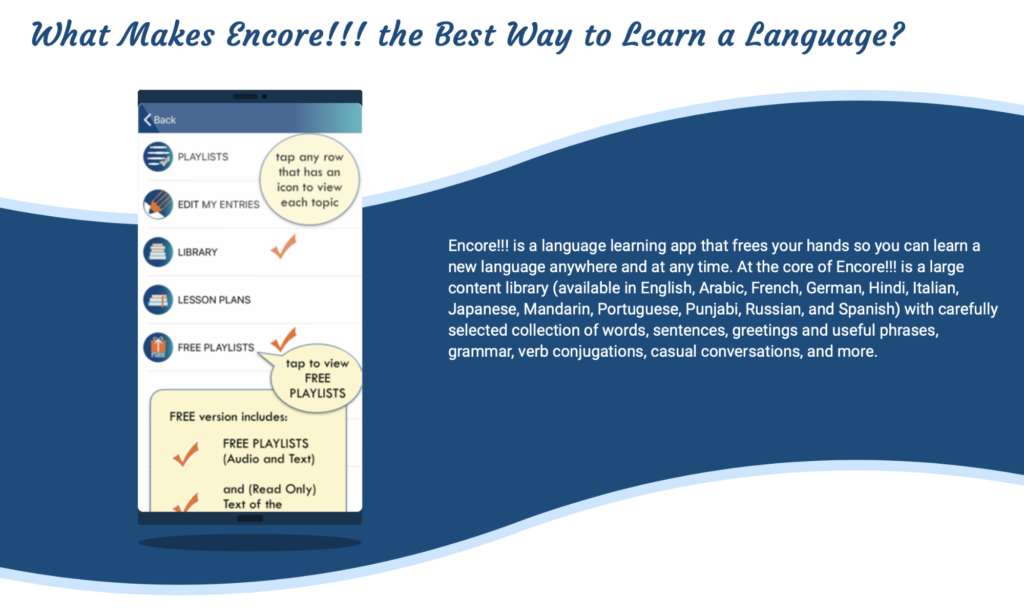
At the time of writing, Encore!!! supports 15 languages, providing thousands and thousands of hours of content for each language. The content is organized into pre-made lesson plans, but users are also free to create their own playlists and add additional content to customize their learning experience. Language learning with Encore!!! is based on repetition, which is a proven language learning strategy and the cornerstone of most language courses.
Encore!!! is also one of the best offline language learning app choices available. You won’t need to worry about signal or internet connection, because Encore!!! lets you do most of the course content completely offline. Of all the language learning apps offline modes, Encore!!! is one of the most robust and feature filled.
You can download and use Encore!!! for free, but it costs $49.99 per language to unlock all content this offline language learning app has to offer. When you compare the price of Encore!!! with the prices of popular language textbooks and courses, it instantly becomes evident why Encore!!! belongs at the very top of our list of the best language learning apps in 2023.
Price: Freemium ($49.99 per language)
Pros: Free version available, can be fully personalized, supports 15 languages, offers a huge content library, offline learning.
Cons: Each language is a separate purchase.
2. Duolingo (Android, iOS, Web)
Duolingo is a popular language learning app that relies heavily on gamification to make learning fun and engaging. Users are motivated to progress through Duolingo courses with virtual coins and other rewards, which they earn for mastering new words, phrases, and grammar. Duolingo keeps track of how individual users are doing, and it adjusts lessons based on their progress and preferred learning style.
With Duolingo, you can learn over 30 different languages, but some courses are more comprehensive and polished than others. Duolingo courses end at the upper-intermediate level, making them suitable mostly for beginners who are looking for a fun way how to learn basic vocabulary, phrases, and grammar.
Duolingo is a popular language learning app that relies heavily on gamification to make learning fun and engaging. Users are motivated to progress through Duolingo courses with virtual coins and other rewards, which they earn for mastering new words, phrases, and grammar. Duolingo keeps track of how individual users are doing, and it adjusts lessons based on their progress and preferred learning style.
With Duolingo, you can learn over 30 different languages, but some courses are more comprehensive and polished than others. Duolingo courses end at the upper-intermediate level, making them suitable mostly for beginners who are looking for a fun way how to learn basic vocabulary, phrases, and grammar.
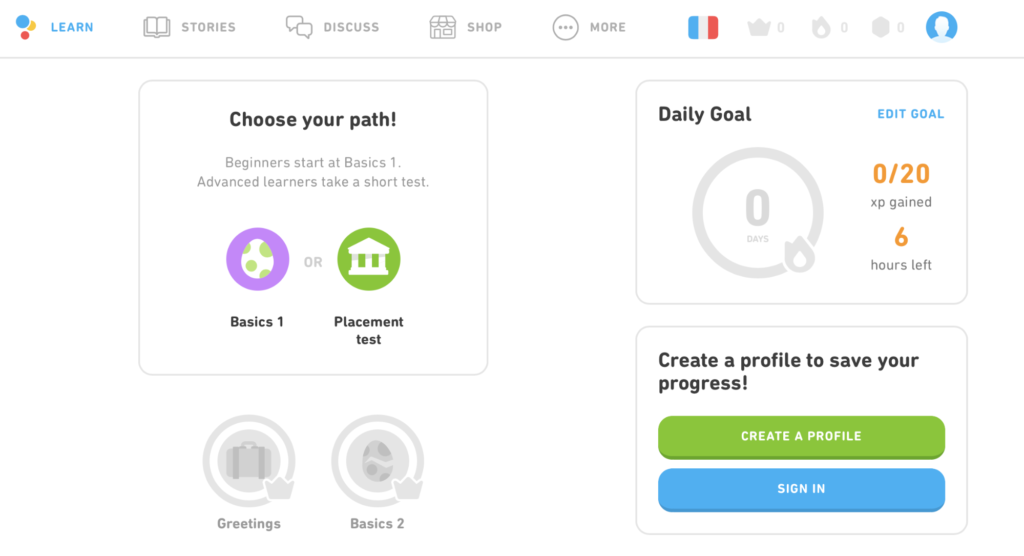
You can use Duolingo for free without any limitations, but there’s also a premium version, which offers several additional features, such as offline courses, learning without ads, and progress quizzes. It’s a good idea to use Duolingo together with other top language learning apps, such as Encore!!!, to progress at a faster pace.
Price: Freemium (Duolingo Plus costs $6.99/month)
Pros: Free plan available, fun gamification of language learning, offers over 30 languages, no user-created content.
Cons: The free version has ads, not all courses are equally polished, ends at the B2 level.
3. Memrise (Android, iOS, Web)
Memrise has been included on many lists of the best apps to learn languages because it provides an enjoyable approach to language learning that helps busy individuals fit bite-size language lessons into their busy days. From a distance, Memrise seems very similar to Duolingo, but there’s one crucial difference between the two best apps to learn a new language: Memrise allows users to create their own content, whereas Duolingo doesn’t.
Because anyone can create a Memrise course, there’s no shortage of content to choose from, and the available courses go beyond language learning, covering everything from arts and literature to math and science. To start learning a language with Memrise, all you need to do is select a language you already speak and then pick the language you want to learn.
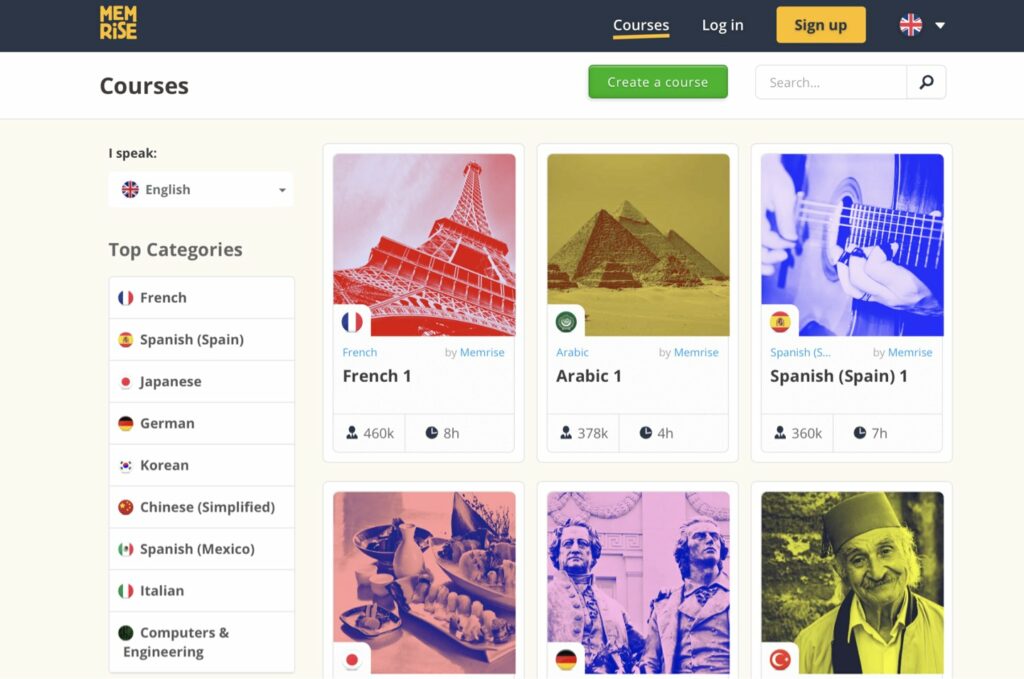
Memrise courses cover all language skills, and they make good use of interactive activities and multimedia. After a while, the content can become repetitive, especially if you use the site to learn multiple languages at the same time. However, the biggest problem is the lack of quality control when it comes to user-created content. This problem is made even worse by the fact that courses are presented in a chaotic way, so users often end up opening a user-created course without even realizing it.
Price: Freemium (Memrise Premium costs $8.99/month)
Pros: Many language learning activities, lots of content available for free, user-created content.
Cons: Can be repetitive, courses are presented in a chaotic way, Memrise Premium isn’t worth the price.
4. Busuu (Android, iOS, Web)
Featuring over 1,000 language learning lessons created by experts, Busuu can supply even the hungriest language learners with enough content to last them for months. You can use it to learn English, Spanish, French, German, Italian, Portuguese, Chinese, Japanese, Polish, Turkish, Russian, and Arabic.
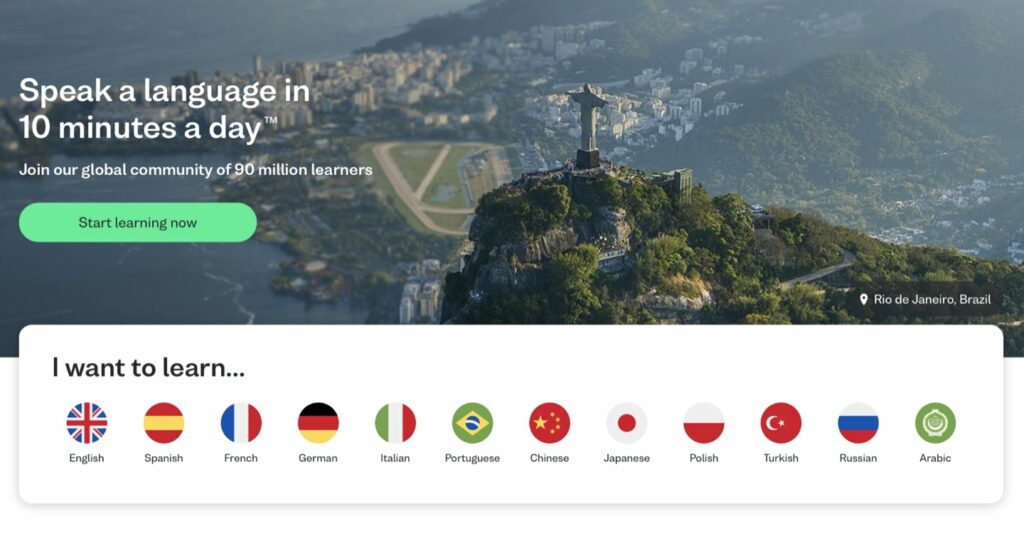
Bussu believes in the importance of feedback from native speakers, which is why it connects over 90 million learners and native speakers. You can get instant feedback on written and spoken lessons from people who actually speak the language you’re trying to learn, which is the main reason why language learners pay expensive tutors.
Unfortunately, this feature is available only with a premium subscription, which costs between $6 and $10/month. Included in the premium subscription is also offline mode, grammar lessons, vocabulary trainer, official certificates, and other features. Without the premium subscription, Busuu feels very limited.
Price: Freemium (Busuu Premium subscriptions costs between $6 and $10/month)
Pros: Feedback from native speakers, offline mode, many language lessons to choose from.
Cons: The most interesting features are available only with a premium subscription.
5. Rosetta Stone (Android, iOS, Web)
Named after the granodiorite stele with texts in Ancient Egyptian and Ancient Greek, Rosetta Stone is a popular language learning software product aimed at organizations and individuals alike. Rosetta Stone presents new vocabulary and grammar in context, without relying on lengthy explanations. It wants language learners to figure things out on their own the same way children learn the language of their parents.
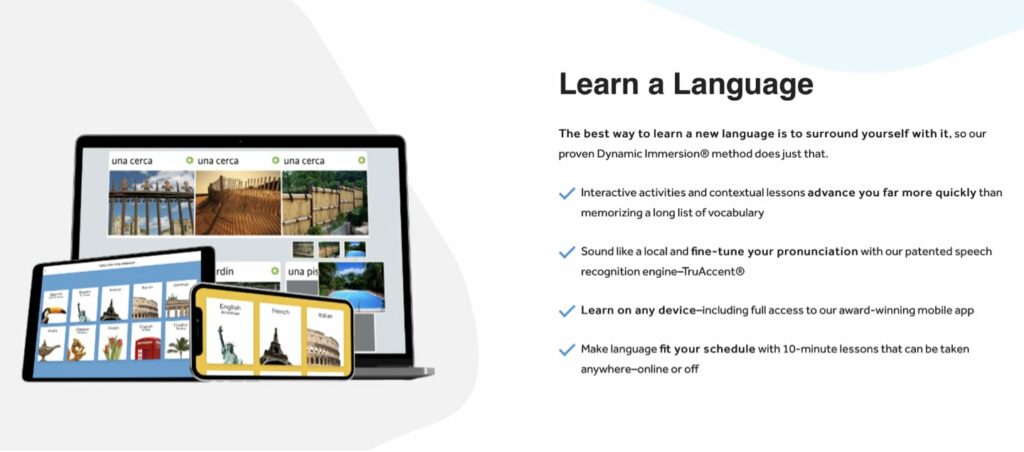
The biggest benefit of this approach is that it makes language learning feel very engaging and accessible. Many language learners who have never enjoyed learning languages at school have found great success with Rosetta Stone, even though the app itself isn’t enough to achieve fluency. The biggest downside of Rosetta Stone’s approach is that grammar concepts can be very difficult to grasp. Users often have to look for explanations on their own, which isn’t exactly ideal considering how much money Rosetta Stone costs.
Rosetta Stone can be purchased either as a downloadable application or used online with a paid subscription. Both versions are virtually identical, featuring interactive courses in all major languages, speech recognition, live online tutoring, as well as various games and activities.
Price: Commercial (Lifetime subscription ranging between $130 and $200, or a monthly subscription that costs between $10 and $35)
Pros: Engaging, great pronunciation practice thanks to speech recognition, over 20 languages to choose from, lessons can be downloaded for offline use.
Cons: Not as effective as Rosetta Stone promises, expensive subscriptions, buggy mobile applications.
6. HiNative (Android, iOS, Web)
HiNative is a unique app to learn languages because it’s actually a questions and answers platform where learners can ask native speakers from around the world questions about language and culture. An app like this is useful the most when used in conjunction with another app, preferably one that provides a structured approach to learning.
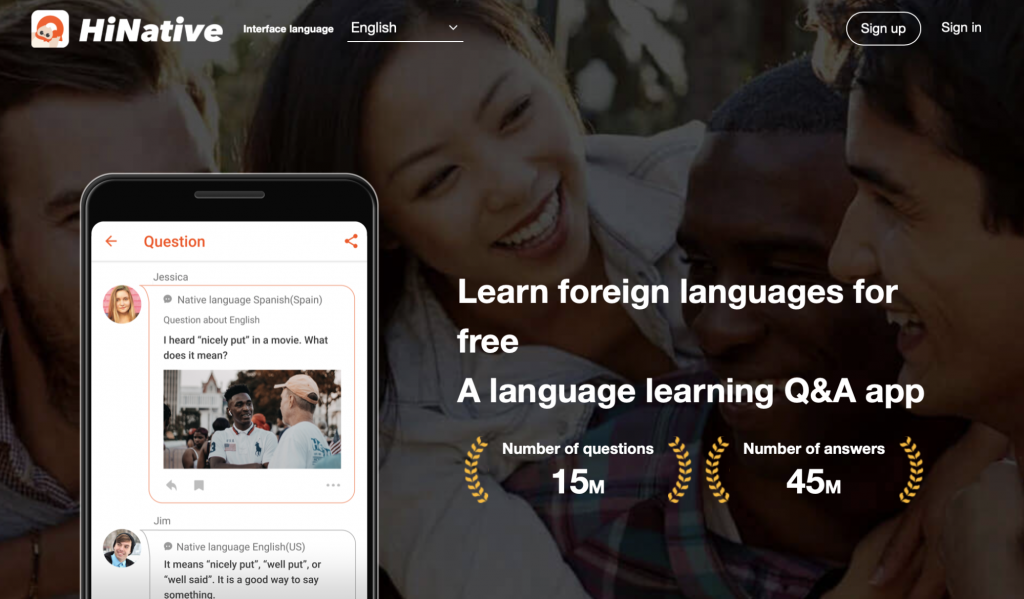
You can get started with HiNative for free and purchase a premium subscription for $5.68/month when paid monthly or $4.96/month when paid annually to unlock additional features. The good news is that the free version offers a lot so spending money isn’t strictly necessary for enjoying this app.
The only thing required is an Android or iOS device with a high-quality microphone so you can post voice questions and answers via a simple app interface. The app features several pre-made question templates that make asking questions easy.
Just keep in mind that you may not always get the most accurate answer because all answers are provided by members of the HiNative community—not professional teachers and linguists.
Price: Freemium (a premium subscription is available for $5.68/month paid monthly, or $4.96/month paid annually)
Pros: Useful free version, active community, most languages are supported.
Cons: You may not always get the most accurate answer, a premium subscription is required to unlock all features.
7. Anki (Android, iOS, Web, Windows, Mac, Linux)
Anki is arguably the best open-source flashcard app, and it’s also the best app to learn a new language without paying any money. Even though Anki isn’t developed specifically for language learners, its amazing spaced-repetition algorithm makes it perfect for the task.
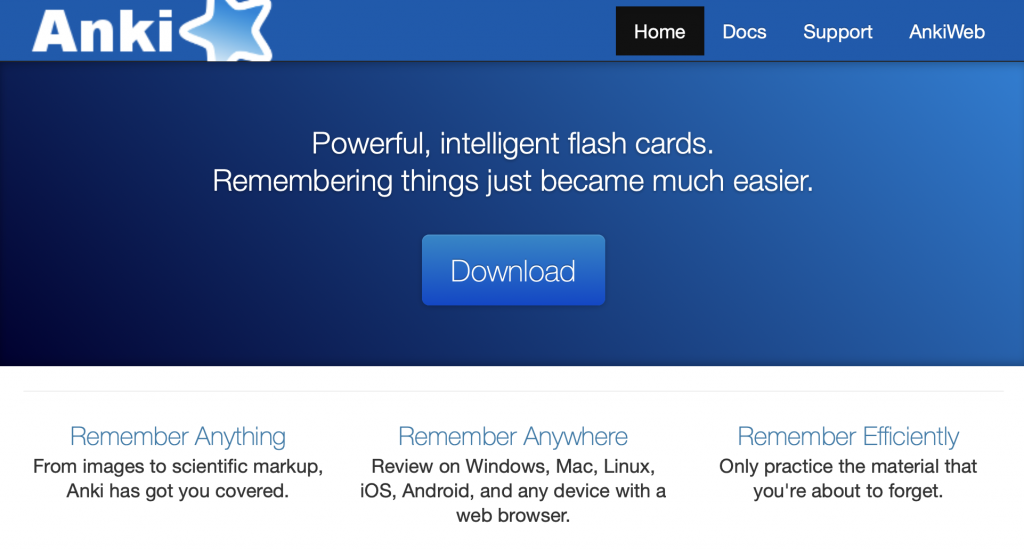
To start learning a language with Anki, you either need to create your own deck of cards or download a pre-made one from the internet. Fortunately, there are great decks for just about any language, but distinguishing them from low-quality decks can sometimes be a pain.
Anki is also one of the best language learning apps that work completely offline, but you can also create a user account and synchronize your progress across devices and platforms. The Android, web, and desktop versions of Anki are free, but the iOS version will cost you $25 for lifetime use.
The biggest downside of Anki is that it takes some time to master because the app offers a lot of features to meet the needs of all kinds of learners—not just those that want to learn a new language.
Price: Free
Pros: Free and open-source, supports all major platforms, customizable.
Cons: Content quality varies greatly, not the most intuitive app.
8. Lirica (Android, iOS)
Music is intertwined with culture and language, which makes it one of the best apps for language learning while experiencing its culture at the same time. Lirica uses music to teach you how to speak a language using hit songs by popular artists. The app drills you one verse at a time, helping you understand the lyrics while teaching vocabulary and grammar simultaneously.
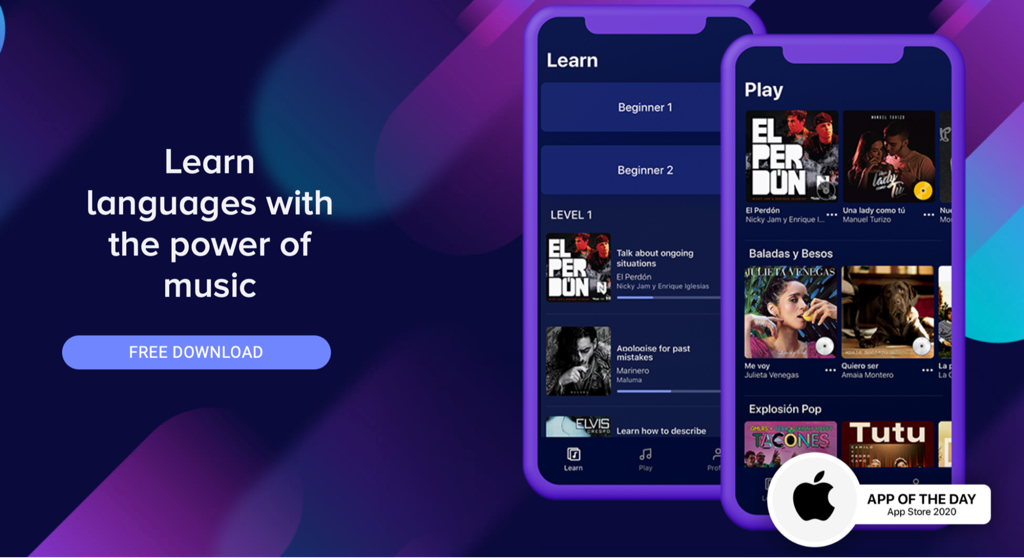
This is a great tool that can be used on its own, or as a supplement to other immersive learning programs. However you choose to engage with the app, Lirica brings some fun to your educational experience. Songs are used to teach children in school, and it is an equally effective tool for adults. From singing your ABC’s to mnemonic songs that are used to teach complex math, music has an ability to embed itself in our minds and allow for fast recall. Think about those “earworm” songs that get stuck in your head, and then imagine that they teach you how to speak Spanish, English, or German!
Currently this language learning app only has Spanish, English, and German available, but more are on the way. This is an innovative approach that will help users to learn in an exciting way. Lirica is available as a free download on Android and iOS, some sample content is also free but full access to the app is $8 a month.
Price: $8 Monthly
Pros: Learn through music, hit songs, learn culture and language together.
Cons: Monthly cost, only 3 languages currently available
9. Tandem (Android, iOS, Web)
One of the best ways to learn a language is to be able to speak to a native speaker. Tandem is a language learning app that allows you to do just that. Part social network and part educational app, Tandem connects you with native speakers so you can exchange languages via conversations. Tandem asks you what language you want to learn and what you are looking for in a partner to exchange with, then connects you with a partner to learn with.

They screen all users to keep everyone safe, and their app features some great tools to help with language learning. They have translation tools, and the ability to make corrections to texts in order to teach your partner. You can communicate via text, voice, or even decide to meet in person. This is on our list of the best free apps for language learning for its unique ability to facilitate natural conversation.
This free language learning app also has a paid version called Tandem Pro. The paid version features include no ads, and the ability to find local native language speakers to exchange lessons with. This language learning app’s offline experience is far different than most others, because it happens in person with another human being.
Price: Free, Paid version is $6.99 Monthly with discounts for longer subscriptions
Pros: Learn from a native speaker directly, actual conversation
Cons: Pro version required for local partners
10. 50Languages (Android, iOS, Web)
50LANGUAGES might be one of the best free language learning app choices available right now. It contains over 50 languages (hence the name) including French, German, Afrikaans, Turkish, Persian and more. The free courses offer 100 lessons taught by native speakers. They also offer free online tests in over 25 of the languages they offer. 50LANGUAGES also offers a wide range of study tools like crossword puzzles, vocabulary cards, and more. This is one of the best free language app choices for basic communication skills.
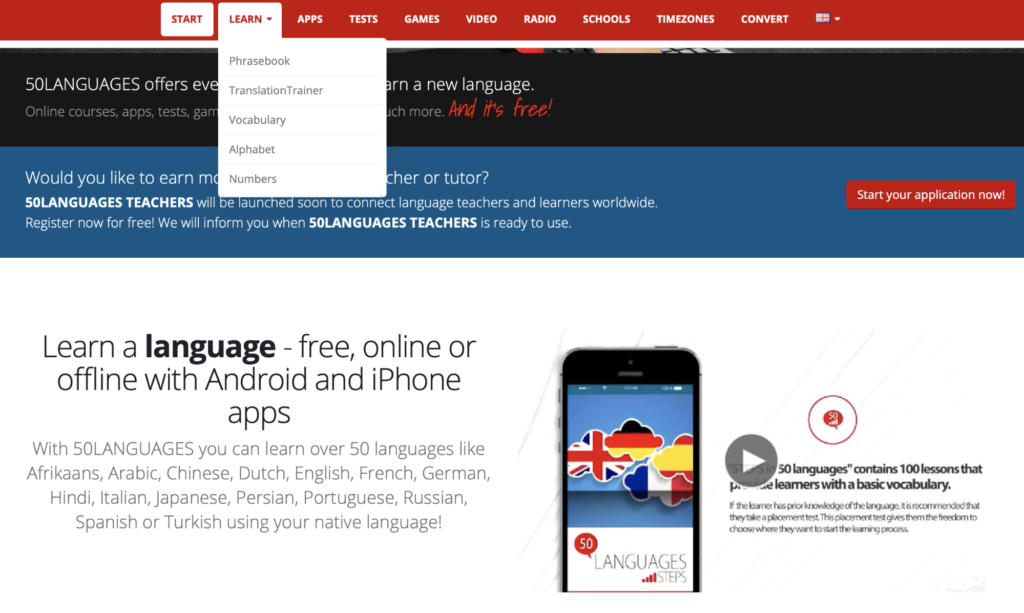
50LANGUAGES also gives you the ability to learn languages offline. With downloadable MP3 audio files for each lesson, you can learn even when there is no internet available. If you want an even more offline experience, 50LANGUAGES also offers books for sale that lets you learn in a traditional textbook style. The offline options are some of the most diverse options that are available from the different language learning apps.
Price: Free, supplemental offline content available purchase.
Pros: Offline language learning app
Cons: Best for beginners, not for more advanced learners.
11. Drops (Android, iOS, Web)
Drops is an interesting new app that is designed for learners who are more visual based. It features over 39 languages and you can decide how much time per day you want to commit to the app. Drop features different categories of words such as food, tech, business, and travel for you to choose from, then “Drops” fall from down your screen and you must choose the correct answers.
Drops is a fun app for learning a language, but it is focused solely on vocabulary. Practice in grammar and speaking will need to be done in another app or learning method, which takes away from some of the potential value of Drops as an app. This is especially true because the free version is capped to short sessions and has ads, and premium starts at $13 a month. It’s a pricey option for a vocabulary only app, but if it compliments your learning style it may be the right app for you.
Price: Freemium with ads, Premium for $13 a month or $69.99 a year
Pros: Fun and unique app, very engaging, great for visual learning
Cons: Cost, only focused on vocabulary
12. LingoDeer (Web, Android, iOS)
LingoDeer is a gamified language learning app that aims to make learning a new language both fun and effective. The app offers courses in a range of languages, including Chinese, Japanese, Korean, Spanish, French, German, Portuguese, and more. LingoDeer’s lessons are designed to be short and interactive, with a focus on building essential language skills like listening, speaking, and reading comprehension.
One of the unique features of LingoDeer is its use of gamification to keep learners engaged and motivated. Each lesson is structured like a game, with points, badges, and leaderboards to incentivize progress. The app also includes a variety of exercises and activities, such as listening and speaking exercises, quizzes, and interactive stories, to help learners practice their language skills in a fun and engaging way. With LingoDeer, language learners can gain confidence and fluency in a new language, all while having fun along the way.
Price: Free (free content is limited), Premium for $14.99 a month or $79.99 a year
Pros: Gamified approach, interactive and comprehensive lessons, offline mode
Cons: Limited conversational practice, limited free content
Conclusion
After reviewing dozens of the best apps to learn a new language, Encore!!! emerged as a winner, giving language learners the opportunity to immerse themselves into the target language anywhere and at any time. You can get started with Encore!!! for free and spend money to unlock more content only when you’re ready. Because Encore!!! lets you create your own language lessons, there are limitless possibilities for you to make it part of your language learning.
FAQs about the Best Language Learning Apps
1. Can you really learn a language from an app?
Absolutely! Apps fall under the Mobile-Assisted Language Learning (MALL) approach to language learning. This approach has been receiving a lot of attention from linguists because it offers a number of important benefits that other approaches don’t offer, such as easy customizability and instant immersion.
2. How to choose the best app for learning languages?
The best app for learning languages should meet several important criteria: it should be affordable, easy to use, customizable, and, above all else, provide learners an extensive collection of high-quality learning material.
3. Is there any app to learn languages offline?
Yes, there are many offline language learning apps. One such app is Encore!!!, and you can download it free of charge on any Android or iOS device.
4. What are the best free language learning apps?
In our opinion, Encore!!! is the best free language learning app out there. With the ability to make your own playlists and learn while going about your daily routine, Encore!!! is an app that will get you results and progress.
5. What is the most effective language learning app?
The most effective app is the one that you will use and devote time and dedication to. It doesn’t matter how good an app is if it doesn’t work with your learning style and you lose interest. Our top option to fit most people’s potential learning styles is Encore!!! due to its flexibility.
6. Are there any completely free language learning apps?
There are free offline language learning app choices out there, but there will also always be a tradeoff in what you might miss out on. 50Languages is a free app that offers some of the most robust choices available. Encore!!! Is an app that is free but has more options available as an upgrade.
7. What are the best language learning apps in 2023?
Here are the top 10 best apps to learn a new language in 2023: Encore!!!, Duolingo, Memrise, Busuu, Rosetta Stone, HiNative, Anki, Lirica, Tandem, and Drops. Each of these apps to learn languages offers a slightly different approach, so don’t hesitate to try them all.

